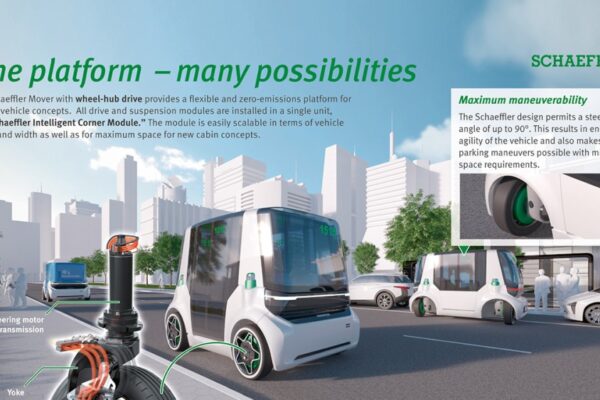
Vehicle concept combines wheel hub drive with 90-degree steering
The technology platform of the “Schaeffler Mover” is designed in such a way that various vehicle bodies can be flexibly implemented, from robo-taxi to autonomous delivery vehicles. With this concept, Schaeffler is responding to the challenge of securing people’s mobility requirements in fast-growing metropolises.
By 2050, two-thirds of the population is expected to live in cities. As habitats become more dense, the way people move around the city and are supplied with goods for their daily needs is changing. Autonomous and electrified vehicles play an important role, especially in the new Robo-Taxis and People and Goods Mover models, which supplement or possibly even replace local public transport in cities. Schaeffler provides the technical basis for such an urban mobility concept: The “Schaeffler Mover” with wheel hub drive and 90-degree steering offers a platform for a wide variety of vehicle concepts such as these Robo-Taxis or autonomous transport vehicles.
The drive and chassis components in the “Schaeffler Mover” are combined in a compact unit, the “Schaeffler Intelligent Corner Module”, to save space. This module, which is installed in all four wheels, comprises the wheel hub motor, wheel suspension and the actuator for electromechanical steering. The steering of the wheel module is designed as an electromechanical steer-by-wire system. The selected shape of the wheel suspension allows a wheel angle of up to 90 degrees. The vehicle can be maneuvered in narrow aisles and merged into short parking spaces. The turning circle of less than five meters makes the vehicle extremely mobile in city traffic. Turning on the spot is also possible.
The traction motor of the wheel module – designed as a permanently magnetized synchronous machine – is a variant of the wheel hub motor developed by Schaeffler as early as 2013 in a research project. In the current design of the “Schaeffler Mover”, each of the four electric motors delivers a continuous output of 13 kilowatts at 300 volts operating voltage and a temporary peak output of 25 kilowatts. The nominal torque of 250 Newton meters per motor can be doubled for a short time.
A specially developed vehicle dynamics control system enables each Intelligent Corner Module to be controlled individually and the functions of vehicle dynamics control (ESP), torque distribution between the driven wheels (torque vectoring) and all-wheel steering to be combined. Lateral movements can thus be implemented with virtually no lateral forces noticeable to the passengers. At the same time, this drive concept guarantees very high availability and reliability. The complete software for drive and steering control has been developed by Schaeffler, including a comprehensive safety concept.
A result of the high degree of integration, the drive and chassis require less installation space overall – the vacated area offers more space for passengers and storage space for goods in transit. The space created for the battery and auxiliary units allows compact vehicle dimensions. These can also be varied. Finally, the vehicle can also be converted to a longer and wider variant without having to make changes to the drive and chassis. The modular vehicle structure of the “Schaeffler Mover” creates the prerequisite for implementing numerous passenger and goods transport tasks with a largely uniform chassis. The body – which can be converted for the desired application – can be quickly separated from the platform, in which all the technology required for driving is bundled. Only some of the sensors required for autonomous driving are also integrated in the body.
Connectivity is a crucial prerequisite for the smooth operation of autonomous city vehicles. The automotive supplier achieves this in the study with a digital twin of the vehicle, which represents an image of the real vehicle in the cloud. Ongoing analysis of operating and status data makes it possible, for example, to identify future maintenance requirements with a time lead time.
he feasibility study, which was presented at the 11th Schaeffler Colloquium, will be gradually developed further in the near future. In the course of the year, it is planned to implement a prototype ready for operation, including cabin and air conditioning.
Related articles:
Wheel hub drive offers superior power density at low cost
Schaeffler to launch e-mobility business unit
Schaeffler taps IBM’s expertise for the connected car
Audi introduces racing car for formula E
Schaeffler touts electrification, efficiency as its R&D focus
 If you enjoyed this article, you will like the following ones: don't miss them by subscribing to :
eeNews on Google News
If you enjoyed this article, you will like the following ones: don't miss them by subscribing to :
eeNews on Google News




